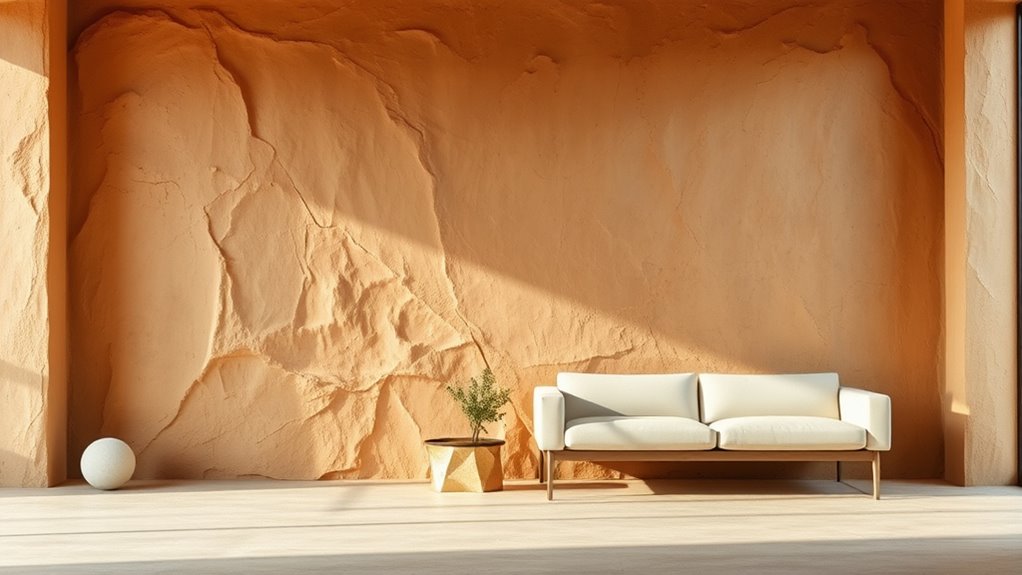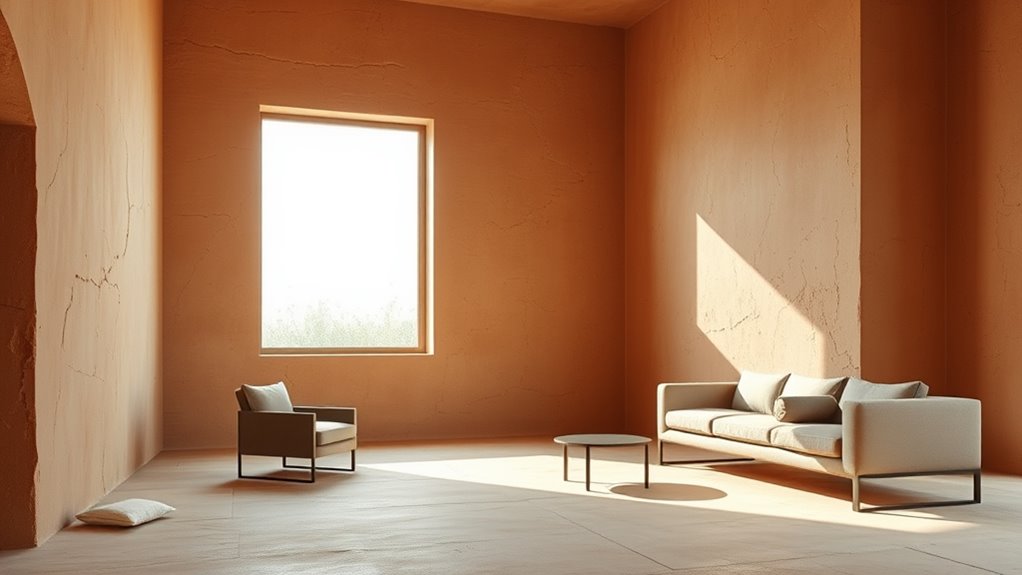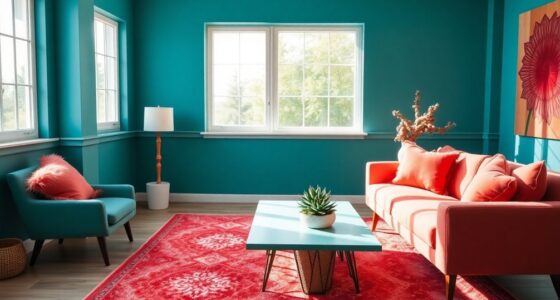Raw clay tones bring a natural, authentic feel to modern interiors by blending earthy hues and textured finishes. They evoke a sense of warmth and connection to nature, creating spaces that feel both grounded and inviting. Incorporating imperfections and rustic details highlights craftsmanship, while pairing these elements with contemporary materials achieves a balanced, timeless look. If you explore this further, you’ll discover how to craft spaces that are genuine, warm, and aligned with the beauty of nature.
Key Takeaways
- Incorporate earthy hues and textured ceramics to evoke authentic, primitive warmth within contemporary spaces.
- Use rustic finishes and natural imperfections to celebrate craftsmanship and add character to modern interiors.
- Pair raw clay tones with natural materials like wood and linen for a cohesive, organic aesthetic.
- Blend primitive earthiness with sleek, minimalist designs for a balanced, timeless look.
- Utilize tactile ceramic textures and matte finishes to create inviting, grounded environments that connect to nature.

Have you ever noticed how raw clay tones evoke a sense of earthiness and authenticity in pottery and design? These shades, reminiscent of natural clay, bring a grounded, organic feel that instantly connects your space to the earth. When you incorporate raw clay tones into your interiors, you’re not just adding color—you’re creating an experience rooted in nature. One way to achieve this is through ceramic textures, which highlight the tactile quality of the material. These textures—whether smooth, matte, or subtly rough—invite touch and add depth to your decor. They remind you of handcrafted pottery, where each piece bears unique imperfections and character. This inherent rustic charm speaks to a desire for authenticity, steering away from overly polished, sterile surfaces.
Raw clay tones evoke earthiness and authenticity through tactile ceramic textures and rustic finishes, creating warm, natural, and inviting spaces.
Rustic finishes are another key element when working with raw clay tones. They emphasize natural imperfections, such as uneven glazes, subtle cracks, or irregular contours, which enhance the raw, unrefined aesthetic. When you choose rustic finishes for furniture, tiles, or decorative accents, you celebrate imperfection and craftsmanship. These finishes can be applied to a variety of materials, from wood to concrete, creating a cohesive look that feels both timeless and welcoming. Combining ceramic textures with rustic finishes results in interiors that feel warm, inviting, and deeply connected to nature. It’s about embracing the beauty of the raw and the imperfect, allowing your space to tell a story of authenticity and tradition.
In practical terms, raw clay tones work beautifully in spaces where you want to foster a sense of calm and grounding. Think about a kitchen backsplash with textured ceramic tiles in earthy hues or a living room accent wall with a matte, rustic plaster finish that mimics clay. These elements add visual interest without overwhelming, maintaining a subtle sophistication. Furthermore, exploring remote hackathons can be a great way to gather innovative ideas for designing such spaces, connecting with global designers and artisans. Pairing raw clay tones with natural materials like wood, linen, or jute amplifies the organic feel, creating a harmonious environment that resonates with simplicity and authenticity. This approach also lends itself well to modern minimalist designs, where the focus is on quality and natural beauty rather than excess ornamentation.
Ultimately, integrating raw clay tones through ceramic textures and rustic finishes transforms your interior into a sanctuary that celebrates primitive earthiness while remaining undeniably modern. You get to enjoy a space that feels genuine, warm, and rooted in the natural world, all while embracing contemporary design sensibilities. It’s about finding that perfect balance—where history and modernity blend seamlessly, offering a timeless appeal that speaks to your appreciation of authenticity.
Frequently Asked Questions
How Does Raw Clay Influence Indoor Air Quality?
Raw clay can positively influence your indoor air quality by aiding in air purification and moisture regulation. As you incorporate raw clay into your space, it absorbs airborne pollutants and excess humidity, helping to create a healthier environment. You’ll notice fresher air and a balanced atmosphere, making your home more comfortable. This natural material acts as a passive, sustainable way to maintain ideal indoor air quality and humidity levels effortlessly.
Are Raw Clay Tones Suitable for High-Traffic Areas?
Think of raw clay tones as the sturdy oak in your home—beautiful yet resilient. They’re suitable for high-traffic areas, but you should watch for durability concerns and color consistency. Over time, foot traffic might wear down the surface or cause slight color variations, so proper sealing and maintenance are key. With attentive care, these earthy hues can withstand daily hustle while adding warmth and authenticity to your space.
What Maintenance Is Required for Raw Clay Finishes?
To maintain raw clay finishes, you should regularly clean with a soft, damp cloth and avoid harsh cleaners. Sealing techniques are essential; apply a breathable sealant to protect against stains and moisture, especially in high-traffic areas. Reapply the sealant every 1-2 years or as needed. This upkeep guarantees your raw clay surfaces stay beautiful and durable, emphasizing their earthy charm while remaining easy to care for.
Can Raw Clay Tones Be Combined With Other Materials?
You can absolutely mix raw clay tones with other materials to create stunning contrasts. Think of it as hitting two birds with one stone—using natural textures like wood, metal, or glass enhances the earthy feel. For a balanced look, focus on color pairing; warm neutrals complement the clay’s rustic charm, while cooler shades add modern sophistication. This blend elevates your space, making it both warm and contemporary.
How Do Raw Clay Tones Affect Room Acoustics?
Raw clay tones can positively affect your room acoustics by enhancing sound absorption, reducing echo, and minimizing noise. Their natural, porous texture helps dampen sound waves, creating a more comfortable, peaceful environment. Incorporating raw clay elements promotes acoustic enhancement, making spaces feel warmer and more inviting. You’ll notice improved clarity and a calmer atmosphere, especially in rooms where sound quality matters most, like living rooms or studios.
Conclusion
Embrace the earthy elegance of raw clay tones to enrich your interiors with timeless texture and warmth. By blending boldness with balance, you bring a beautiful bridge between primitive roots and modern refinement. Let these organic hues inspire your space, encouraging a sense of serenity and sophistication. With raw clay tones, you create a cozy, current ambiance that connects past and present in perfect harmony. Transform your home into a haven of harmonious hues and heartfelt history.









